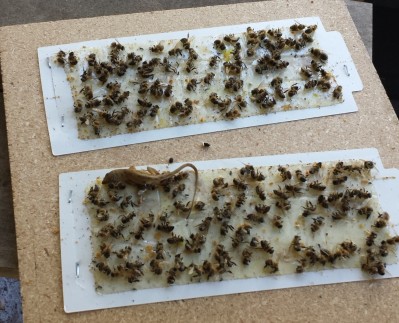I built a small mite board using sticky pest strips a while back. It worked, but you had to keep buying the strips, and the sample area was small. The new mite board is bigger and instead of sticky strips uses white coated masonite board and spray oil.
The bottom board (right) is the white coated masonite with a 1×2 cleat attached to the bottom. Its purpose will be more obvious later. The top that holds the screening is a 1×2 ripped in half and held together with small angle brackets. Everything got a coating of bright yellow spray paint as much for ascetics as for environmental reasons.
Once the paint had cured I put down more of my aluminum 1/8″ screening. Looks good, but I am starting to wonder if my use of yellow for every bee related article is over doing it… NAHHHHH!
Now to put it under the hive. Before I do, I gave the mite board a heavy spray of cooking oil. The coated masonite shouldn’t soak anything up, so when I am done I can clean it and use again as many times as I want.
It looks good under the hive, and the cleat is more obvious now. Just sit the top on there, and slide it back until you hit the cleat. It also gives you something substantial to quickly grab and get away. Trust me, you don’t want to spend a lot of time messing around under there.
The board works perfectly, I am really happy with this design. It installed quickly, caught the mites, didn’t cost much, is super reusable, doesn’t trap bees, looks great, and makes it very easy to see mites. The only problem is that I have a lot of mites.
It is hard to distinguish in the above picture, but there are dozens from a single day of monitoring. We are going to have to start doing something immediately. I have read good things about the powdered sugar treatment. I still have honey supers on, so I can’t use some of the really aggressive stuff. A single powdered sugar treatment isn’t highly effective, but done consistently week after week, it can supposedly knock down the population. Our starting numbers are really high, so hopefully it can only go down from here. Look at those horrible buggers!






















